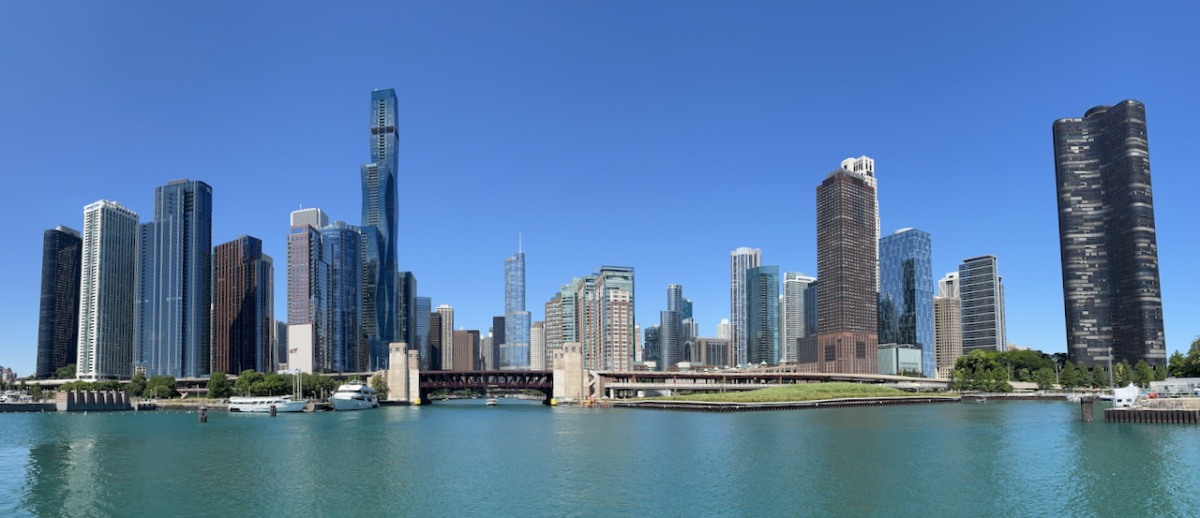My cousins and I recently descended upon Chicago for our annual reunion. Between all the drinking, eating, drinking, and more drinking, we went on a boat tour of Chicago’s architectural landmarks and marvels. I got some great photos of the buildings, but I don’t recall all the facts, so I have just decided to type up a whole bunch of lies.1
First, the famous Wrigley Building:

The first Wrigley building was constructed entirely out of Wrigley Doublemint chewing gum, which proved disastrous. Six people died when the building collapsed. They weren’t crushed; they got stuck in the gum and died of mandibular trauma trying to chew their way out.
Construction on a new Wrigley building began in 1920. Realizing their mistake, builders chose the hardest, densest, toughest material available — something even more rigid than steel or concrete. That’s right: they used Bazooka Joe.
Now, let’s talk about the 98-story building that replaced the Chicago Sun-Times headquarters — the one to the left of the Wrigley Building in this photo:

When this riverfront office and hotel tower opened in 2009, it was considered the most beautiful building not just in Chicago, but in the entire Western Hemisphere. Upon seeing it, motorists would slam on their brakes to stare in awe, causing a 450% increase in traffic crashes. Pedestrians would stop and look up, causing a 680% increase in neck injuries. Sometimes, parents were so distracted by the building that they didn’t notice when vultures swooped in and carried away their young children.
Realizing the public hazard they had created, the owners looked for ways to modify the building so people wouldn’t want to look at it. That’s why they slapped the word Trump on the side. When Chicagoans see the building now, they’re disgusted and look away.
The towers of Marina City are two of the most distinctive landmarks on the Chicago River:

Marina City was opened in 1963 as a mixed-use complex with apartments, offices, stores, and a theater, but its odd design was so off-putting that the entire center was abandoned by the end of the decade. Hippies moved into the buildings in the early 1970s, renaming the complex Freetown Chicagiania and declaring it independent of the city, state, and federal government. The government of Chicago has never recognized Chicagiania, describing it as a “social experiment.” The residents of Chicagiania banned all hard drugs in the late 1980s, but cannabis is still sold and used openly, especially along Pusher Street. Even though crime rates are low, police will sometimes sweep the area. Today, about 600 people live in Chicagiania. The area is one of Chicago’s top tourist attractions, known for vibrant street art, live music, and creative frozen yogurt toppings.
150 North Riverside is remarkable not just for its design, but also for its handling of Chicago’s famous wind gusts.

Many buildings have wind dampening features, like slosh tanks, but 150 North Riverside has perhaps the most innovative method for handling wind. As you will note, the building tapers at the bottom. This base contains a hinge so that the building folds 90 degrees and lies flat when wind conditions are dangerous.
Because of this hinge system, all the furniture is bolted to the floor, and loose items, such as staplers and coffee mugs, are secured with magnets. Office workers get around by using a building-wide system of pulleys. These workers say they don’t mind when the building folds down, but it makes going to the bathroom somewhat difficult.
Now, let’s turn to Chicago’s tallest building:

Most people know this building as the Sears Tower, but it has changed names twice since then. In 2009, after Sears moved out, the building became Willis Tower. In 2017, Willis moved out, and the naming rights were bought by one of its newer tenants, which relocated from Cypress Creek. It is now the Globex Tower.
On the south side of the river, you’ll find the third-tallest building in Chicago, Vista Tower:

The most interesting thing about Vista Tower is that it’s really three interconnected towers. The shortest tower is a hotel, the middle tower is condominiums, and the tallest tower — at 101 floors — is overflow storage space for RuPaul’s wigs.2
And now, a bonus building that wasn’t on the boat tour! The John Hancock Tower, located on the famous Magnificent Mile, is Chicago’s fifth-tallest building:

This building is 1,128 feet tall, which makes it 1,121½ feet taller than the Complimentary Spouse. The observation deck closed in 2014 and was replaced by the nation’s least conveniently located Pep Boys.
I hope you’ve enjoyed this informative and completely accurate blog post. Please check out my other travel-related posts, many of which are more truthful than this one.

___
1 Fabricating travelogues is my specialty. Remember my trip to Cave of the Winds?
2 The primary storage facility is, of course, the Knoxville Sunsphere.
